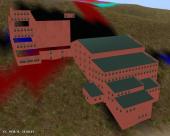   |
Economic Mill
|
Last updated: 03.06.2006 18:27
|
02.06.2006
 Thanks to
a very friendly & helpful seller at ebay I was able to
at least get a glimpse of some of the info in the 1904
Annual report of the United Gold Mines Company, typical my
luck I was unsuccessful of winning it as my US$350 was no
match for those with way larger bank accounts then mine, but
at least I got some help in getting to know what this
reports holds as before this listing I had no idea at all.
So, thank you so much!! Thanks to
a very friendly & helpful seller at ebay I was able to
at least get a glimpse of some of the info in the 1904
Annual report of the United Gold Mines Company, typical my
luck I was unsuccessful of winning it as my US$350 was no
match for those with way larger bank accounts then mine, but
at least I got some help in getting to know what this
reports holds as before this listing I had no idea at all.
So, thank you so much!!
 Should
you the reader of this have access to this annual report, I
would love to hear from you - I'm after the info in it, not
the report it self per say, so please email me if you are
willing to help! Should
you the reader of this have access to this annual report, I
would love to hear from you - I'm after the info in it, not
the report it self per say, so please email me if you are
willing to help!
 The
little info I have is listed at bottom here. The
little info I have is listed at bottom here. |
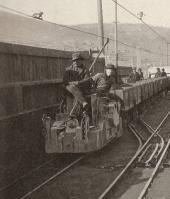 |
22.01.2006
 Thanks
to a listing on ebay for some expansive gold stuff (bar/medallions)
I found a short newspaper article related to the fire that removed
this mill from the face of the earth and into the history. As the
image was not very clear I will rewrite it in here below instead
of showing a screenshot of it - you find the
info at bottom of page. Thanks
to a listing on ebay for some expansive gold stuff (bar/medallions)
I found a short newspaper article related to the fire that removed
this mill from the face of the earth and into the history. As the
image was not very clear I will rewrite it in here below instead
of showing a screenshot of it - you find the
info at bottom of page.
14.01.2006
 Another year is
here, and I still have tons of stuff to do, like this mill. None
is done, sorry, but I have found what I think is a date for the
picture below with that Prince Hohenlohe in it. Seems like the
good Prince and party had a roundtrip in Colorado in summer of
1904 as I found an article about him visiting Breckenridge on his
tour of Colorado! Cool to find that. :-) Another year is
here, and I still have tons of stuff to do, like this mill. None
is done, sorry, but I have found what I think is a date for the
picture below with that Prince Hohenlohe in it. Seems like the
good Prince and party had a roundtrip in Colorado in summer of
1904 as I found an article about him visiting Breckenridge on his
tour of Colorado! Cool to find that. :-)
05.11.2005
|
 Not
really an update, I have put this mill aside as I got stuck
on the figuring out part... :-( Not
really an update, I have put this mill aside as I got stuck
on the figuring out part... :-(
 But
earlier this year I bought an old folder of ebay, and that
had one big surprise for me, one that I was so happy to
get!! :-) But
earlier this year I bought an old folder of ebay, and that
had one big surprise for me, one that I was so happy to
get!! :-)
 Just look at
the picture at right of here, don't that look cool or what?
LOL Just look at
the picture at right of here, don't that look cool or what?
LOL
 Now,
to be able to make a model of this, the cars, and the tunnel
and the mine/mill complexes... Now,
to be able to make a model of this, the cars, and the tunnel
and the mine/mill complexes...
Oh well, life has to turn around soon so I
can get back to Cripple Creek modeling. |
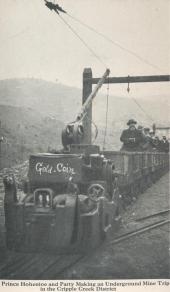 |
|
I found this lovely picture in an folder,
seems like celebrity visited Cripple Creek, just wish I knew
a year to help date this picture. -> |
26.09.2004
 I've been busy with other
stuff, and been waiting for new memory for the AMD. We now have 2GB of RAM
in it, 1GB stick times two from Crucial - and it behaves much better.
Trainz and gmax can now be open at the same time without crash - but still
I haven't had as much time as I wanted to work on the mill. I've been busy with other
stuff, and been waiting for new memory for the AMD. We now have 2GB of RAM
in it, 1GB stick times two from Crucial - and it behaves much better.
Trainz and gmax can now be open at the same time without crash - but still
I haven't had as much time as I wanted to work on the mill.
 I've been doing some work
the last two days, I want a working model for a project I have in my head
- so I need to speed up my progress. I've been doing some work
the last two days, I want a working model for a project I have in my head
- so I need to speed up my progress.
 What I have done is add
the building that cover the tunnel opening, and a basic brick box to be
used as a start on the office/assayer building - as seen on far left on
some of the real pictures I have. What I have done is add
the building that cover the tunnel opening, and a basic brick box to be
used as a start on the office/assayer building - as seen on far left on
some of the real pictures I have.
 So, to show some progress
to who ever is out there reading this, here's some pictures! :-) So, to show some progress
to who ever is out there reading this, here's some pictures! :-)
 |
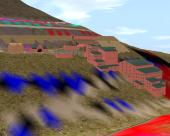 |
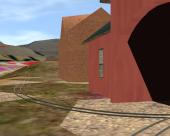 |
.jpg)
Compare to the model at left |
04.09.2004
For the last week I've been using this model to test out a new computer we
bought on a trip to Norway we just been on. The computer is a AMD 64bit,
but seamed to have some problems when running both Trainz and gmax so I've
had to try figure that out.
But, this page is not about that, so, instead, latest news are that I got
the book I waited for - almost missed it in Norway! Book is nice, it's
old, fragile, seams to have all the maps and such - but, the small
words it had about this mill, not very helpful alas... :-(
But, I've been trying my best of matching pictures and Sanborn map, but I'
about to stop again as I just can't seam to be able to match is as good as
I want!
Below is the pictures for today, first out is a couple of screens showing
my model and it's "model" - pictures of real mill! After that,
you will see some more pictures of the model and the 18" mine train I
guess they used - except, it was a trolley system, the yellow engine in
pictures are a battery train for lack of better...
 |

The real Mill, compare to model at left. |
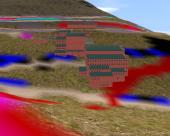 |
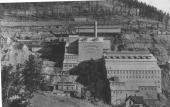
The real Mill, compare to model at left. |
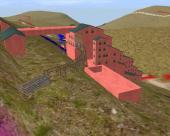
A view from the hillside |
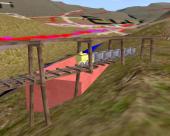
A closer look at the train1 |

A closer look at the train2 |
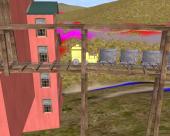
A closer look at the train3 |
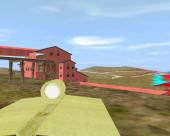
And, this is the view from the train itself, coming out of the
tunnel from the Gold Coin. |
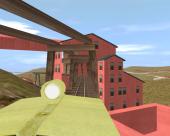
I have yet to model the road that was above the track, this part is
mostly guesswork. |
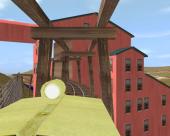
Pictures I have is not good enough to make out details, but it looks
quite good... |
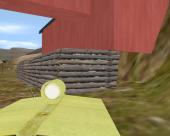
This part I made today, as you see, the building at left is higher
up then track... |
06.08.2004
I've made some doors so the workers can get in and out - and from what I
can tell, their now happy... :-) Other then that, not much have happen to
the mill model.
Did put a Sanborn Map on the bottom of the model, more or less scaled to
the model as I couldn't get the info from my CAD program that I needed as
I had removed the Sanborn Map after I traced it - therefore, no X,Y
coordinates to use...
Reason I put in the Sanborn was that I had hoped it would help me place
this mill better inside of Trainz - but after spending some time in there
I still think it's not good enough.
05.08.2004
 Latest update on my never
ending job on the Economic Mill is that I finely after nearly 8 months
have open up my gmax file again and started on doing a model for Trainz! Latest update on my never
ending job on the Economic Mill is that I finely after nearly 8 months
have open up my gmax file again and started on doing a model for Trainz!
 My computer do not like to
run my CAD program in 3D anymore, so I haven't actually drawn anything new
- just been busy last 3 days getting the X,Y,Z info out of my CAD drawings
for the windows so I could put them into my Trainz model. My computer do not like to
run my CAD program in 3D anymore, so I haven't actually drawn anything new
- just been busy last 3 days getting the X,Y,Z info out of my CAD drawings
for the windows so I could put them into my Trainz model.
 As a window texture I've
used a picture I took at the Western
Mining & Industry Museum in Colorado Springs. The stamp mill they
have there had some nice textures I just had to have a few pictures of...
:-) The roof is for the moment made from a picture of a red tarpaper roof
in Alma, Colorado recolored into a blackish tarpaper roof... And, walls
are made from a reddish iron/metal siding picture of the Coeur D' Alene
mine in Central City. As a window texture I've
used a picture I took at the Western
Mining & Industry Museum in Colorado Springs. The stamp mill they
have there had some nice textures I just had to have a few pictures of...
:-) The roof is for the moment made from a picture of a red tarpaper roof
in Alma, Colorado recolored into a blackish tarpaper roof... And, walls
are made from a reddish iron/metal siding picture of the Coeur D' Alene
mine in Central City.
 Today I hope to make a
couple of door textures as I would guess the workers in the mill would
like to get out once in a while and not having to crawl out the window...
:-) Today I hope to make a
couple of door textures as I would guess the workers in the mill would
like to get out once in a while and not having to crawl out the window...
:-)
I will also try to put in some of the roof awnings or whatever they are
caller, think I did drawn them long time ago. Other then the above mention
I don't think I can get much further as I still would prefer to work from
a drawing where time is spent to try match pictures as close as possible
then to just spend some time in gmax just making something that's more or
less correct.
 After I got some weeks
back an old article about a Chlorination Mill in Florence, Colorado with
some drawings from that one I got a little better understanding on some of
the words used on the Sanborn Map, but still, there's so much I don't
know! After I got some weeks
back an old article about a Chlorination Mill in Florence, Colorado with
some drawings from that one I got a little better understanding on some of
the words used on the Sanborn Map, but still, there's so much I don't
know!
 I bought my self a expensive
book called "The Official Manual of Cripple Creek", dealing with
the companies of that area in 1900 in hope of learning more - didn't find
much of interest for this mill. I bought my self a expensive
book called "The Official Manual of Cripple Creek", dealing with
the companies of that area in 1900 in hope of learning more - didn't find
much of interest for this mill.
 I also have a book in
shipping dealing with the Geology of the area, according to a friend that
one is suppose to have a short description of the workings of this mill +
several pages about the Gold Coin Mine which this mill was connected to
via the Columbine/Victor Tunnel - so I eagerly awaits the day I can have a
look in that book! :-) I also have a book in
shipping dealing with the Geology of the area, according to a friend that
one is suppose to have a short description of the workings of this mill +
several pages about the Gold Coin Mine which this mill was connected to
via the Columbine/Victor Tunnel - so I eagerly awaits the day I can have a
look in that book! :-)
 But, for now, I will put
in some doors, fix the textures so it's proportions are more correct and
then, try make my self a new mine tunnel from a short description of the
Columbine/Victor tunnel and have it connected to my mill in Trainz! The
left most picture under
here actually shows the tunnel I use as of today as the Gold Coin
connection tunnel. But, for now, I will put
in some doors, fix the textures so it's proportions are more correct and
then, try make my self a new mine tunnel from a short description of the
Columbine/Victor tunnel and have it connected to my mill in Trainz! The
left most picture under
here actually shows the tunnel I use as of today as the Gold Coin
connection tunnel.
|
|

|
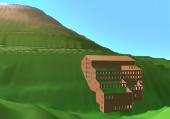
Fig.1 |
 Economic Mill in
Eclipse Gulch is my first attempt of
buildings/structures of the Cripple Creek District. Mainly because from the very first picture
I saw of it, it SCREAMED to me, please, please make a model of me!! J
It have taken long
time, but I'm about half done, making plans from pictures is not easy! Economic Mill in
Eclipse Gulch is my first attempt of
buildings/structures of the Cripple Creek District. Mainly because from the very first picture
I saw of it, it SCREAMED to me, please, please make a model of me!! J
It have taken long
time, but I'm about half done, making plans from pictures is not easy!
 But, I recently got an old picture of the
buildings that helped me make out a little more of the left side - as you can see
here on the left - thanks Mike! But, I recently got an old picture of the
buildings that helped me make out a little more of the left side - as you can see
here on the left - thanks Mike!
 From my books I have found 5 pictures, the one Mike sent me made #6 - and all 6 of them
shows a different building!! Not much, but it is obvious that the Wood brothers rebuilt
they're mill "all the time"... From my books I have found 5 pictures, the one Mike sent me made #6 - and all 6 of them
shows a different building!! Not much, but it is obvious that the Wood brothers rebuilt
they're mill "all the time"...
 I bet they did it just to confuse me about a 100 years later... J
I bet they did it just to confuse me about a 100 years later... J
 Anyway, I have to use some artistic liberty since this building is long gone - it burned
down early morning on the 30th January 1907 [Lowell Thomas's Victor] - but I think I've closing into capturing the feeling of this massive
building! And I'm happy with that. Anyway, I have to use some artistic liberty since this building is long gone - it burned
down early morning on the 30th January 1907 [Lowell Thomas's Victor] - but I think I've closing into capturing the feeling of this massive
building! And I'm happy with that.
 I started by using what I suspect is the
oldest picture of the complex (Fig.3). This one shows the front very
good, so I scanned that and put it into a CAD program called 3rd PlanIt. I started by using what I suspect is the
oldest picture of the complex (Fig.3). This one shows the front very
good, so I scanned that and put it into a CAD program called 3rd PlanIt.
 There I scaled the picture so the
windows matched some H0 scale windows I have that looked similar to the ones in the picture. There I scaled the picture so the
windows matched some H0 scale windows I have that looked similar to the ones in the picture.
 After that it was just using that size to try match the other measurements up so it at least
seams to match the pictures, not always easy when you have 6 different ones...
After that it was just using that size to try match the other measurements up so it at least
seams to match the pictures, not always easy when you have 6 different ones...
 Well, OK, they aren't that different, but it has made me confused sometimes.
Anyway, Fig.4 is showing the drawing I first made.
Well, OK, they aren't that different, but it has made me confused sometimes.
Anyway, Fig.4 is showing the drawing I first made.
 Then, I got sick and tired of this massive work, so I took a break for a month or two. That
lasted until
I saw this last picture on the Internet (Fig.2) and just had to try get it. It made me feel for
starting the drawing process again - and make this page your reading... J Then, I got sick and tired of this massive work, so I took a break for a month or two. That
lasted until
I saw this last picture on the Internet (Fig.2) and just had to try get it. It made me feel for
starting the drawing process again - and make this page your reading... J
 Until today I've constructed some of the buildings in virtual H0 scale using 3rd PlanIt
just so I could check that my drawing is correct. The first picture (Fig.1) is showing the model I made. Until today I've constructed some of the buildings in virtual H0 scale using 3rd PlanIt
just so I could check that my drawing is correct. The first picture (Fig.1) is showing the model I made.
 But, I've still has some more drawing to do, not to even mention the actual modeling of this
massive structures in real life model and virtual model!
But, I've still has some more drawing to do, not to even mention the actual modeling of this
massive structures in real life model and virtual model!
 So, I'm back to the drawing board!
So, I'm back to the drawing board!
Update! - 11102003
 Well, I've been
working on and off for some time now - been busy trying to learn some dutch also... The main
problem of hitting the wall is bugging me (again..),
even with the Sanborn Fire Insurance maps on hand. Mostly it is the old problem of missing info and what to do
with the walls/sides I don't see in the pictures... Well, I've been
working on and off for some time now - been busy trying to learn some dutch also... The main
problem of hitting the wall is bugging me (again..),
even with the Sanborn Fire Insurance maps on hand. Mostly it is the old problem of missing info and what to do
with the walls/sides I don't see in the pictures...
 The most recently
problem with the Sanborn map and the pictures not agreeing with each other, have made me to
almost give up on this one and just try following the pictures as close as I could, but using the Sanborn as a starting point, and as
a reference point. So it is sort of turning into some sort of a caricature of what it was, not
a perfect match... The most recently
problem with the Sanborn map and the pictures not agreeing with each other, have made me to
almost give up on this one and just try following the pictures as close as I could, but using the Sanborn as a starting point, and as
a reference point. So it is sort of turning into some sort of a caricature of what it was, not
a perfect match...
 Latest
(11102003) development is shown here. Latest
(11102003) development is shown here.
Fig.14 - View 3D of main mill, from the left, over the Sanborn map trace. (Pic)
Fig.15 - View 3D of main mill, from the front, over the Sanborn map trace.
(Pic)
Fig.16 - View 3D of main mill, from the right, over the Sanborn map trace.
(Pic)
 And, here is
some older
(22092003) views. The lower building (roaster building) is nearly redone like this
pictures shows: And, here is
some older
(22092003) views. The lower building (roaster building) is nearly redone like this
pictures shows:
Fig.7 - Top view of the Roaster building on top of the Sanborn map trace.
(Pic)
Fig.8 - Left side of drawing Roaster building. (Pic)
Fig.9 - Front side of drawing Roaster building. (Pic)
Fig.10 - Right side of drawing Roaster building. (Pic)
Fig.11 - Back side of drawing Roaster building. (Pic)
Fig.12 - View 3D of Roaster building. (Pic)
Fig.13 - View 3D from above, over the Sanborn map trace. (Pic)
 Older
info, Fig.5
is a scan of the Sanborn map dated 1900, I've cleaned it up since this scan, and have been figuring out measurements from
it. But, even if it did answer some of my question it raised even more since this building don't
match all my photo's as mentioned earlier... Older
info, Fig.5
is a scan of the Sanborn map dated 1900, I've cleaned it up since this scan, and have been figuring out measurements from
it. But, even if it did answer some of my question it raised even more since this building don't
match all my photo's as mentioned earlier...
 And, there are
numbers that I think relate to a table or something with more info, and I learned that the
maps was originally made in color, but my source only has the B/W copies that was microfilmed
some years ago - wish I could get hold of color copies instead... And, there are
numbers that I think relate to a table or something with more info, and I learned that the
maps was originally made in color, but my source only has the B/W copies that was microfilmed
some years ago - wish I could get hold of color copies instead...
 Anyway, this pic (Fig.6)
shows what I had made until my Norway trip, but since this didn't match what I have found out
by tracing the Sanborn map (Fig.5), I decided to redo it. OK, it wasn't
that off, more like a drawing with a scale from around 1:90, and mine was draw it in H0 scale (1:87)! J Anyway, this pic (Fig.6)
shows what I had made until my Norway trip, but since this didn't match what I have found out
by tracing the Sanborn map (Fig.5), I decided to redo it. OK, it wasn't
that off, more like a drawing with a scale from around 1:90, and mine was draw it in H0 scale (1:87)! J
 But, some measurements
where in a scale higher, like 1:93, some in 1:88 and so on, but working with just pictures I'm
still quite happy I got this far. But, some measurements
where in a scale higher, like 1:93, some in 1:88 and so on, but working with just pictures I'm
still quite happy I got this far.
 But, quite happy is not what I want, I want
perfect - even if I know there are almost no chance of me ever get to that point, but still I
started to redo the
drawing - even if I have to spend lots and lots of hours of work all over again... But, quite happy is not what I want, I want
perfect - even if I know there are almost no chance of me ever get to that point, but still I
started to redo the
drawing - even if I have to spend lots and lots of hours of work all over again... |

Fig.2 |
.jpg)
Fig.3 |
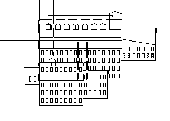
Fig.4 |
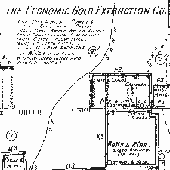
Fig.5 |
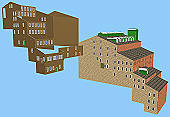
Fig.6 |
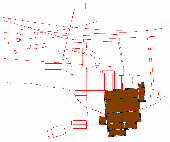
Fig.7 |

Fig.8 |
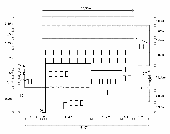
Fig.9 |
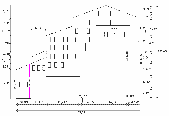
Fig.10 |
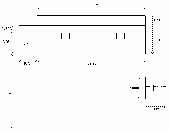
Fig.11 |
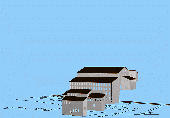
Fig.12 |
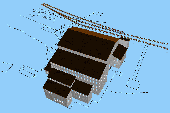
Fig.13 |
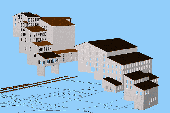
Fig.14 |
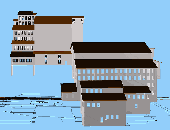
Fig.15 |
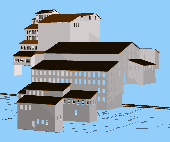
Fig.16 |
|
|
|
|
|
| From Lowell Thomas's Victor: |
 At approximately 2 P.M., carriages picked up the Roosevelt party and
drove them through a short tour of Victor. Then the group was driven to the Gold Coin Shaft House built with red pressed bricks and colorful
stained glass windows. At approximately 2 P.M., carriages picked up the Roosevelt party and
drove them through a short tour of Victor. Then the group was driven to the Gold Coin Shaft House built with red pressed bricks and colorful
stained glass windows.  Seventy-five people accompanied Roosevelt down
the main shaft of the mine to its eight hundred foot level. Mr. and Mrs.
Harry Woods-still dressed in their luncheon finery-performed the honor of being Mr. Roosevelt's guides. Seventy-five people accompanied Roosevelt down
the main shaft of the mine to its eight hundred foot level. Mr. and Mrs.
Harry Woods-still dressed in their luncheon finery-performed the honor of being Mr. Roosevelt's guides.
 Harry Woods pointed out the Gold Coin vein as they traveled a quarter
of a mile down the drift. In one stope, Roosevelt was handed a pick and offered the chance to dig his own ore. He happily relieved himself of his
hat and coat, then started to work. The $500 worth of ore he loosened from the vein was sacked and presented to him. Harry Woods pointed out the Gold Coin vein as they traveled a quarter
of a mile down the drift. In one stope, Roosevelt was handed a pick and offered the chance to dig his own ore. He happily relieved himself of his
hat and coat, then started to work. The $500 worth of ore he loosened from the vein was sacked and presented to him.
 The party returned to the first level of the mine and rode fifteen mine
cars, headed by an electric locomotive, three-quarters of a mile under Squaw Mountain to the Woods' Economic Extraction Mill in Eclipse
Gulch. The Vice-President was shown a lump of gold concentrate recently extracted from Gold Coin ore worth over $20,000. The party returned to the first level of the mine and rode fifteen mine
cars, headed by an electric locomotive, three-quarters of a mile under Squaw Mountain to the Woods' Economic Extraction Mill in Eclipse
Gulch. The Vice-President was shown a lump of gold concentrate recently extracted from Gold Coin ore worth over $20,000.
|
 30 January: fire consumed the Economic Extraction Mill. It was the
largest mill of its kind, built in Eclipse Gulch by the Woods Investment Company in 1899 for $532,000.
30 January: fire consumed the Economic Extraction Mill. It was the
largest mill of its kind, built in Eclipse Gulch by the Woods Investment Company in 1899 for $532,000.
 The fire began at five in the morning in the main mill. Spreading rapidly, it destroyed the ore houses, assay office,
and general offices. Smoke could be seen rising over the summit of Squaw Mountain from any standpoint in Victor. Then wind blew the thick smoke
into the United Mines Transportation Tunnel. The smoke rose up the Gold Coin shaft and filtered into Victor. The fire began at five in the morning in the main mill. Spreading rapidly, it destroyed the ore houses, assay office,
and general offices. Smoke could be seen rising over the summit of Squaw Mountain from any standpoint in Victor. Then wind blew the thick smoke
into the United Mines Transportation Tunnel. The smoke rose up the Gold Coin shaft and filtered into Victor.
 Since the mill was not in use, insurance on the structures had not been
kept up. Negotiations had been underway to convert the mill into a cyanide plant for processing gold ore. The mill was never rebuilt. Since the mill was not in use, insurance on the structures had not been
kept up. Negotiations had been underway to convert the mill into a cyanide plant for processing gold ore. The mill was never rebuilt.
|
 From a friend:
From a friend:
I can tell you this about the Victor-Columbine Tunnel: it was well-bored.
When we were in it – opened by the mining company of the time
specifically for our inspection – it was in excellent condition. The
ceiling was 8 to 10 feet tall in most places. The width was 6 to 8 feet.
There were several connecting laterals along the way from Arequa Gulch to
the Gold Coin shaft. The tracks from the electric tramway had either been
extracted or buried. There was a strange mold raising from the floor of
the tunnel: a white stringy like plant that floated with the light breeze
(created by the hole opened for us to crawl through at the top of the
tunnel). This mold broke up easily as we walked through it. Of course, the
tunnel was moist; and, contained a “dead-air” smell in it. It was in
remarkably good shape for being near a century old. It was especially erie
at the end of the tunnel, where it connected with the shaft, as one could
look up (about 600 feet) to see a speck of the sky; and, down into an
abyss of darkness.
It was definitely a different experience, like walking back into
time. Although there were about 5 or 6 of us on the journey, I felt alone
in the tunnel, cold from the high humidity, oppressed by the rock all
around. My friend, Joe Vanderwalker, who had basically grown up in such
circumstances – having worked in the Cripple Creek mines most of his
life – had wanted the mining company to consider re-opening the tunnel
as a tourist attraction for Victor, with an electric tram and mining
history displays. Alas, the whole tunnel opening, as well as the ruins of
the Economic Extraction Mill, are buried beneath at least a hundred feet
of waste rock, which fills a good portion of the head of Arequa Gulch.
|
 From Geology and Gold Deposits of Cripple Creek District (page 143) by
Lindgren & Ransome - USGS Professional paper 54:
From Geology and Gold Deposits of Cripple Creek District (page 143) by
Lindgren & Ransome - USGS Professional paper 54:
The Economic mill at Victor, with a capacity of 800 tons, roasts
after crushing in seven Argall furnaces and one Pearce furnace, both
burning crude Florence oil. The chlorination takes place in seven 20-ton
lead-lined revolving barrels, 17,5 by 8 feet. Chlorine is generated by
sulphuric acid and calcium oxychloride. The agitation occupies three
hours. The filtrate goes to settling tanks and thence to five steel
precipitating tanks 8 by 10 feet. Hydrogen sulphide is the precipitant
used. After passing through filter presses the cakes of gold sulphide are
roasted in shallow iron pans, mixed with flux, melted in a wind furnace in
large graphite crucibles, and the gold finally poured out in 700-ounce
bricks.
|
 From a newspaper article written 1 February
1907 (Unknown paper):
From a newspaper article written 1 February
1907 (Unknown paper):
Men armed with Winchesters yesterday guarded the
ruins of the Economic mill on the west side of Squaw
mountain in Eclipse gulch, as a protection against
thieves, who are said to have carried away brass,
copper and other valuable metals the day prior.
It was while men were engaged in saving what part of
the property they could that it was discovered young
ruffians were ransacking the ruins. One of
the youths was caught in the act and forced to
relinquish his spoils and while no more trouble was
given by him the rummaging continued, as did the fire.
At that time only the night watchman, R.A. Walcott,
was on the ground to prevent depredations, but several
more guards were on duty yesterday each carrying a
Winchester rifle on his shoulder. Frank
Woods, of the Woods Investment company in charge of
the mill, did not arrive from Denver, being detained
on business. He is expected today.
While investigation is being made into the origin of
the fire practically no tangible evidence is furnished
to work on, and yesterday's effort bore no fruit.
That the mill will not be rebuilt is authoritatively
stated. |
 From the 1904 Annual Report
of the United Gold Mines Company:
(If you have
it, could you please help me with some info as I don't
have it?)
From the 1904 Annual Report
of the United Gold Mines Company:
(If you have
it, could you please help me with some info as I don't
have it?)
* The track for the tunnel is laid with 35-pound
rails.
* The transportation company owns ninety-five
ore cars and a Morgan electric Locomotive.
* It takes less then five minutes to make the distance
from the Gold Coin Mine to the mill with a 25 ore car
train.
|
|
Page loaded:

|


.jpg)


















.jpg)













